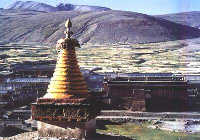| |
Sagya Monastery
( 2005-10-27 )
 The other two were called the Two Founders in Red, as they who became lamas, abided by Buddhist principles, and excelled in Buddhism. They were Gonggar Gyaincain, who was knowledgeable and respected as a man of wisdom, and Pagba, a famous Buddhist scholar and political activist. The other two were called the Two Founders in Red, as they who became lamas, abided by Buddhist principles, and excelled in Buddhism. They were Gonggar Gyaincain, who was knowledgeable and respected as a man of wisdom, and Pagba, a famous Buddhist scholar and political activist.
During the times of Gonggar Gyaincain and Pagba, they visited the emperors of the Yuan Dynasty twice, thus making great, historical progress in integrating Tibet into the territory of China. In 1260, Pagba was granted the title of State Master by the Kubla Khan of the Yuan Dynasty, and later, the titles of Great King of Dharma and Teacher of the Emperor.
The Yuan Dynasty conducted a census in Tibet, established a prefecture that ruled 130,000 households, set up posts, sent troops to the region, and appointed head officials of Sagya to represent the Central Government in tackling political affairs in the area, thus establishing the ruling status of the Sagya Sect in Tibet. The Yuan Government also set up the General Council (later the Political Council) to administer national religious affairs and administrative affairs in Tibet.
The Sagya Monastery is proclaimed as the "SecondDunhuang," and boasts many classical books, relics, and rich and preciousmural paintings, the finest collection of remaining Tibetan religious relics. More than 40,000 volumes of books are housed there. Thetemplealso stores 21 volumes of Buddhist scriptures on pattra leaves (originally over 100 volumes). On each pattra are Buddhist scriptures written in Sanskrit. Each volume contains 100 to 200 pages, including four-color illustrations.
Also in the monastery are ancient porcelain wares,jadebowls, gold-gilt Buddha statues, armors,musical instrumentsused in Buddhist mass, robes, boots,seals, tangka painting scrolls, satins and silks, and numerous other rare relics presented to the Prince of Dharma in Sagya by emperors of the Central Plains through the dynasties.
Murals in the monastery, superb and representing the epitome of Tibetan murals, depict Buddhist stories, portraits of Princes of Dharma of Sagya through the dynasties, Pagba's meeting withKublai Khan, and the construction scene of the Sagya Monastery. Wrought in a vigorous, meticulous style, the murals, as rare artifacts, are fresh and lively with various compositions.
|
|

